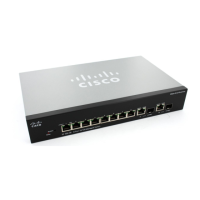VLAN Management
Defining VLAN Membership
Cisco Small Business 300 Series Managed Switch Administration Guide 115
11
Defining VLAN Membership
The Port to VLAN Page, VLAN To Port Page, and Port VLAN Membership Page
display the VLAN memberships of the ports in various presentations. You can use
the Port to VLAN Page and the VLAN To Port Page to add or remove
memberships to or from the VLANs.
When a port is forbidden default VLAN membership, that port is not allowed
membership in any other VLAN. An internal VID of 4095 is assigned to the port.
To forward the packets properly, intermediate VLAN-aware devices that carry
VLAN traffic along the path between end nodes must either be manually
configured or must dynamically learn the VLANs and their port memberships from
Generic VLAN Registration Protocol (GVRP).
Untagged port membership between two VLAN-aware devices with no
intervening VLAN-aware devices, should be to the same VLAN. In other words, the
PVID on the ports between the two devices must be the same if the ports are to
send and receive untagged packets to and from the VLAN. Otherwise, traffic might
leak from one VLAN to another.
VLAN-tagged frames can pass through VLAN-aware or VLAN-unaware network
interconnection devices. If a destination end node is VLAN-unaware, but is to
receive traffic from a VLAN, then the last VLAN-aware device (if there is one), must
send frames of the destination VLAN to the end node untagged. That is, the egress
port that reaches the end node must be an untagged member of the VLAN.
Configuring Port to VLAN
Use the Port to VLAN Page to display and configure a VLAN and all its port
members on a single page.
To map ports or LAGs to a VLAN:
STEP 1 Click VLAN Management > Port to VLAN. The Port to VLAN Page opens.
STEP 2 Select a VLAN and the interface type (Port or LAG), and click Go to display or to
change the port characteristic with respect to the VLAN.

